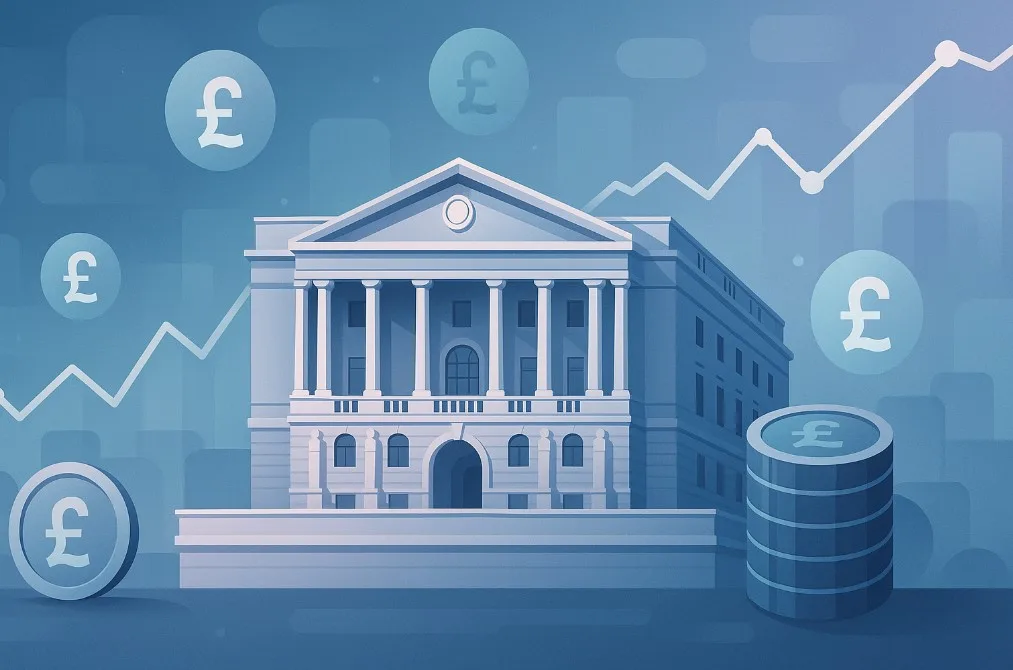Table of Contents
ToggleWhat Is the Bank of England Interest Rate and Why Does It Matter?
How does a single percentage set by the Bank of England (BoE) hold the power to shape the UK’s economic direction? Known as the Bank Rate, this benchmark interest rate currently stands at 4.0%, as of the last decision made on 18 September 2025 by the Monetary Policy Committee (MPC). While it might seem technical, this rate affects everything from mortgage payments and business lending to savings returns and inflation control.
The BoE interest rate serves as the cost for commercial banks to borrow from the central bank. These banks, in turn, use it as a foundation to set their own rates impacting individuals and businesses nationwide. This makes the Bank Rate a core instrument in shaping monetary policy, managing inflation, and maintaining financial stability in the UK economy.
How Does the Bank of England Use the Bank Rate to Manage the Economy?

At the heart of the BoE’s monetary policy is a singular target inflation, which it aims to maintain around 2%. The Bank Rate acts as a lever that can either stimulate or slow down economic activity.
When inflation rises above this target, as it currently has, the Bank typically raises interest rates to make borrowing more expensive and saving more attractive. This discourages excessive spending and cools demand, which in turn helps lower inflation.
Conversely, when inflation is below target or when the economy requires stimulation, the Bank can lower rates to encourage borrowing and investment.
The 4.0% interest rate in place as of September 2025 reflects a careful balancing act. It follows a period of tighter monetary policy during which the rate peaked at 5.25%, triggered by inflationary pressures post-pandemic and the energy price shocks of 2022.
The decision to hold the rate steady at 4.0% shows a shift from aggressive rate hikes towards maintaining stability, suggesting that inflation may be gradually falling in line with expectations, but not quite enough to warrant a rate cut.
Why Did the MPC Hold the Rate at 4.0% in September 2025?
On 18 September 2025, the Monetary Policy Committee voted to keep the base rate at 4.0%, ending a series of successive hikes that began in 2022. The decision came amid signs of easing inflation, though it remained above the 2% target. Core indicators such as energy prices, wage growth, and consumer spending suggested that the economy was beginning to stabilise.
The MPC’s rationale for maintaining the rate was to avoid undermining progress made in controlling inflation. A premature cut could reignite price pressures, particularly as consumer demand picks up and wage increases persist across several sectors.
This pause provides breathing space for both consumers and businesses, offering predictability after years of volatility.
However, the MPC’s statement indicated that rates could remain at this level for an extended period until there is greater confidence that inflation is returning to target.
How Have Bank of England Interest Rates Evolved Over Time?
The BoE interest rate has undergone significant changes over the past two decades, shaped by global financial events, political shifts, and domestic challenges. From the aftermath of the 2008 financial crisis to the COVID-19 pandemic and Brexit, each period has brought its own monetary response.
Below is a historical overview of BoE base rate decisions over the past 15 years.
Bank of England Interest Rate History (2010–2025)
| Year | BOE Base Rate (%) | Economic Context |
| 2010 | 0.50 | Post-global financial crisis recovery |
| 2016 | 0.25 | Brexit referendum leads to economic uncertainty |
| 2020 | 0.10 | COVID-19 pandemic triggers emergency rate cuts |
| 2022 | 1.25 | Inflation begins to rise post-lockdowns |
| 2023 | 4.75 | Response to high inflation and energy costs |
| 2024 | 5.25 | Peak rate as inflation remains persistent |
| 2025 | 4.0 | Rate stabilised as inflation begins to ease |
The dramatic rise from 0.10% in 2020 to 5.25% in 2024 was one of the most aggressive tightening cycles in the BoE’s history. It reflected urgent efforts to counter inflation that surged due to disrupted supply chains, labour shortages, and global energy volatility.
What Role Does the Bank Rate Play in Everyday Financial Decisions?

The Bank Rate touches almost every part of a household’s or business’s financial life. When the Bank Rate changes, it influences the interest rates charged or paid by commercial banks and lenders.
This has a direct impact on how much people pay on mortgages or loans, and how much they earn from savings accounts.
For example, a homeowner on a variable-rate mortgage will see their monthly repayments change as soon as lenders adjust their rates following an MPC announcement. Similarly, savers might benefit from higher returns on their deposits when interest rates rise though not all banks pass on increases equally or immediately.
Borrowing becomes more expensive when rates rise, affecting not only mortgages but also car loans, credit cards, and business financing. This can lead to reduced consumer spending and delayed investment, especially among small businesses that depend on affordable credit.
How Does the BOE Interest Rate Affect Mortgages, Loans, and Savings?
The Bank Rate operates like a financial domino. Once adjusted, it sets off a chain reaction throughout the UK’s financial system. For mortgages, the most immediate effect is on tracker and variable-rate deals. When the Bank Rate increases, so do the repayments on these types of mortgages, sometimes significantly.
Fixed-rate mortgages remain unaffected until the deal ends, but new fixed-rate deals tend to become more expensive in high-rate environments. This puts pressure on both first-time buyers and existing homeowners looking to remortgage.
Savings accounts, on the other hand, may benefit from a higher Bank Rate, particularly for fixed-rate bonds or ISAs. However, the extent to which savers benefit depends on the competitiveness of banks and the speed with which they respond to BoE changes.
For personal loans and credit cards, higher base rates usually translate to increased costs. This can lead to a tightening of household budgets and discourage the use of credit, especially for non-essential spending.
Who Is Most Affected by Changes in the Bank of England Interest Rate?
Interest rate changes affect everyone, but not equally. Those with large outstanding debts or on variable-rate financial products are particularly vulnerable. A small rise in rates can significantly impact monthly budgets, especially when combined with broader inflationary pressures.
Small businesses also feel the effects, especially those relying on overdrafts or short-term credit facilities. Higher borrowing costs can constrain growth, reduce hiring plans, and delay capital investment. In contrast, pensioners or individuals with significant savings may benefit from improved interest income, helping them to cope with rising living costs.
The housing market is another area where rate changes ripple quickly. Higher rates typically dampen demand by making mortgages less affordable, which in turn affects house prices and the construction sector.
How Does the Bank of England Use Interest Rates to Control Inflation?

Inflation is the rate at which prices for goods and services rise. When inflation exceeds the BoE’s 2% target, the central bank may increase the Bank Rate to make borrowing more expensive. This reduces spending and investment, easing upward pressure on prices.
The logic is straightforward: higher interest rates reduce disposable income and discourage credit-fuelled consumption. This helps cool demand, which in turn limits price increases. Conversely, if inflation is below target or the economy is stagnating, the BoE may lower the Bank Rate to stimulate activity.
In 2022, when inflation exceeded 10%, the Bank responded with a series of sharp rate increases. These decisions were instrumental in bringing inflation back under control by 2025, though not without side effects such as slower growth and reduced investment.
How Should Individuals and Businesses Respond to Changing Interest Rates?
Understanding how to respond to interest rate changes is essential for maintaining financial health. For individuals, this might mean reviewing mortgage terms, switching to fixed-rate deals, or paying off high-interest debt more aggressively. For savers, it’s worth exploring high-yield savings accounts or bonds that benefit from increased rates.
Businesses, particularly startups, should reassess their cost structures and funding strategies. Traditional loans may become less attractive, prompting a shift towards alternative financing options such as equity investment, government-backed grants, or peer-to-peer lending. Planning ahead, maintaining healthy cash flow, and building financial buffers are all essential strategies in a high-rate environment.
What Could Happen to BOE Interest Rates in the Near Future?
Looking ahead, the future path of BOE interest rates remains uncertain. The MPC has signalled a cautious approach. While inflation has shown signs of easing, it remains above target, meaning rates are likely to remain elevated for the short term.
Economists are divided. Some forecast a gradual reduction in rates in 2026, particularly if inflation continues to fall and economic growth slows. Others argue that persistent wage growth and global uncertainties may keep the rate at 4.0% or higher for longer.
What is certain is that the BoE will continue to monitor economic indicators closely—especially inflation, employment, wage growth, and global economic developments before making further moves.
Frequently Asked Questions
How often does the Bank of England change interest rates?
The MPC meets eight times a year, approximately every six weeks, to review economic data and set the Bank Rate.
Why does the BoE aim for 2% inflation?
A 2% inflation rate is considered optimal for economic stability. It allows for moderate price growth while protecting consumer purchasing power.
Can the Bank of England lower rates quickly if needed?
Yes, in extreme economic situations, such as during the 2008 crisis or the 2020 pandemic, the BoE can make emergency rate cuts to support the economy.
Do savings accounts always improve when rates go up?
Not necessarily. While higher Bank Rates offer the potential for better savings returns, banks don’t always pass on the full increase.
How do rate changes affect fixed mortgage deals?
Fixed-rate mortgage holders are protected from immediate changes. However, they may face higher costs when their deal ends if rates remain elevated.
What’s the difference between the Bank Rate and inflation?
The Bank Rate is a tool used to influence inflation. Inflation measures price changes, while the Bank Rate helps control those changes through monetary policy.
Where can I check the latest BOE interest rate?
The official Bank of England website regularly updates the current Bank Rate and publishes minutes of MPC meetings.




